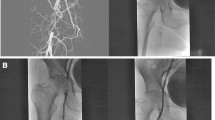Abstract
Introduction
Closure devices are commonly used in neurointerventional procedures to achieve groin hemostasis. These devices are particularly useful in procedures requiring anticoagulation and larger catheters. The suture-mediated Perclose ProGlide device is intended for use with 5F to 8F sheaths. We describe the use of the ProGlide device with 9F sheaths in acute stroke treatment using the Merci retrieval device.
Methods
The ProGlide device is advanced over a wire until the wire exit port is at the skin surface. The wire is removed and the device is advanced until pulsatile blood flow is encountered. The footplates are opened and the stitch is deployed. The footplates are then closed and the device is removed. After advancing the suture to the vessel, it is locked and trimmed. Firm pressure is necessary during deployment to prevent oozing around the device. If continued bleeding is encountered, direct manual pressure is used to achieve hemostasis.
Results
We have successfully used the Perclose ProGlide device in four patients following the Merci retriever without groin or extremity complication. The Perclose ProGlide device can be successfully used after placement of a 9F system in patients who have undergone mechanical thrombectomy.
Conclusion
This technique may be of interest to endovascular surgical neuroradiologists because it affords fast hemostasis in large access sites following mechanical thrombectomy with the Merci retrieval device. Compared to the “Preclose” technique, it saves valuable time at the beginning of the case.
Similar content being viewed by others
References
Smith WS, Sung G, Starkman S et al (2005) Safety and efficacy of mechanical embolectomy in acute ischemic stroke: results of the MERCI trial. Stroke 7:1432–1438
Martinez H, Zoarski GH, Obuchowski AM, Stallmayer MJ, Papangelou A, Airan-Javia S (2004) Mechanical thrombectomy of the internal carotid artery and middle cerebral arteries for acute stroke by using the retriever device. AJNR Am J Neuroradiol 25:1812–1815
Gradinscak DJ, Young N, Jones Y, O’Neil D, Sindhusake D (2004) Risks of outpatient angiography and interventional procedures: a prospective study. AJR Am J Roentgenol 183:377–381
Michaels AD, Ports TA (2001) Use of a percutaneous arterial suture device (Perclose) in patients undergoing percutaneous balloon aortic valvuloplasty. Catheter Cardiovasc Interv 53:445–447
Rachel ES, Bergamini TM, Kinney EV, Jung MT, Kaebnick HW, Mitchell RA (2002) Percutaneous endovascular abdominal aortic aneurysm repair. Ann Vasc Surg 16:43–49
Author information
Authors and Affiliations
Corresponding author
Rights and permissions
About this article
Cite this article
Layton, K.F., White, J.B., Cloft, H.J. et al. Use of the Perclose ProGlide device with the 9 French Merci retrieval system. Neuroradiology 48, 324–326 (2006). https://doi.org/10.1007/s00234-006-0049-4
Received:
Accepted:
Published:
Issue Date:
DOI: https://doi.org/10.1007/s00234-006-0049-4




